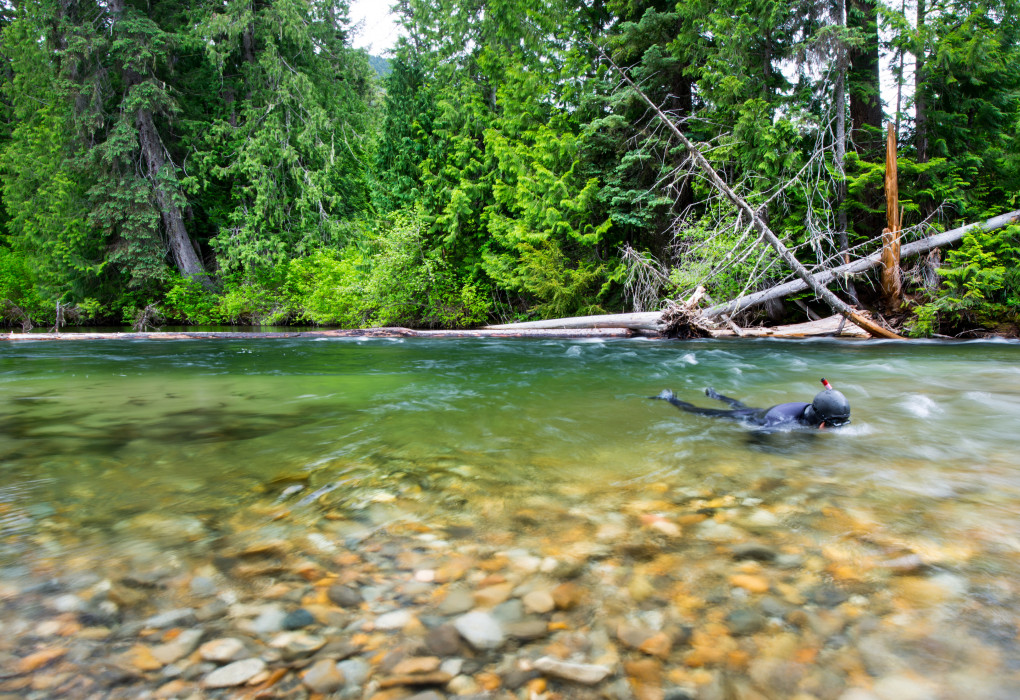Wenatchee Cold Water Campaign
Last year, during a June river snorkel on the Wenatchee River I stumbled upon dozens of adult bull trout, salmon, and steelhead sheltering in the frigid outflow of a small creek. At first, it was exhilarating to see so many big fish tucked so closely together. In the low and clear summer flows, little was obscured – it was surreal – like finding an aquarium stuffed wall to wall with my favorite native fish.
Then, I was hit by a sinking realization. These fish were huddled together because they were fighting for their lives. The tiny creek’s outflow created a ribbon of cold water that functioned like an oasis within the otherwise hot Wenatchee. The survival of these fish relied entirely on the tiny creek and its trickle of cold water.
For many of us, the summer of 2015 was a wake up call. River loving people across the Northwest witnessed first hand as the specter of climate change shifted from vague prediction to backyard reality. Most poignantly for native fish, June’s triple digit temperatures combined with record low snowpack spelled disaster for nearly half a million Columbia River salmon, steelhead, and trout, which perished due to high water temperatures before they could complete their annual spawning migration.
Last summer’s extreme conditions prompted me to ask several questions about my homewaters: Does the Wenatchee contain enough cold water habitat to support both young and adult fish, especially during the summer and early fall? Do certain cold water areas play an especially critical role in protecting upriver migrating fish that are forced to navigate rapids or dams? Have all these cold water areas been catalogued and are they protected from the human activities that would increase their temperatures or reduce their flows?
To begin answering these questions, I met with Native Fish Society staff, state, local, and federal fisheries biologists. After a few months work it became clear that too little was known about these important places. As a result, NFS staff and I developed a project to identify, assess, and monitor the cold water refuges in the mainstem Wenatchee River during the summer of 2017.
To get a complete picture of these cold water refuges, a few different data gathering techniques will be used. First, to gauge the extent and duration of cold water refuges, tiny digital temperature monitors will be placed at the outflow of 12 small tributary streams. Additionally, new advances in technology mean we can utilize forward-looking (FLIR) cameras and recreational unmanned aerial vehicles (UAVs) to collect overhead thermal imaging, which will help us locate and detail the size of these cold water areas. To assess which cold water refuges are the most hospitable for fish, a number of environmental factors will be measured and scored including depth, flow, riparian habitat, woody structure, and location. Last, snorkel surveys will determine the presence of different fish species and catalog their varying life stages to get a baseline understanding of native fish currently using these refuges.
Taken together, these factors will be crunched into a score for each cold water area, which will help wild fish advocates, fisheries agencies, habitat restoration entities, and land-use decision makers based in the Wenatchee watershed understand which cold water refuges are currently the most vital for native fish and where additional cold water habitats are needed. As it stands, land use regulations largely ignore intermittent streams too small for fish passage. And yet, it’s our hypothesis that these small streams will play a critical role in our evolving climate landscape.
How can you help?
Right now Native Fish Society is raising support for our Wenatchee Cold Water Campaign. Your donations will help us purchase equipment, conduct fieldwork, and compile our study’s results into a report that can be accessed free to the public. Once we have the equipment on hand, we hope to deploy similar studies on watersheds across the Northwest with the help of our River Steward community. There are also some great incentives for those who contribute to this crowd funding effort – to check them out and donate head to nativefishsociety.org/get-involved.
Second, we hope to challenge you to look carefully at your own watershed in a new way and take your own citizen science findings to the people who might otherwise ignore these small, yet critical, sources of cold water. The Wenatchee isn’t the only watershed that needs its cold water refuges protected!
To get started, buy a water thermometer and use it to identify thermal refuges in your homewaters. Investigate and ask tough questions that demand answers. Share your findings. Explore rivers both above and below the surface. Get involved. My work as a River Steward is more than reforming hatcheries and removing dams, it’s to learn and then teach and most of all act on behalf of the creatures that cannot speak for themselves.


